Reflective Writing on Aims, Experience, and Business Research Insights
VerifiedAdded on 2023/06/12
|8
|1834
|295
Essay
AI Summary
This reflective essay explores a student's learning journey through business research, focusing on small businesses and employment in Australia. The reflection covers the student's initial perceptions, the transformative impact of the research, and the identification of barriers faced by small businesses. It details the learning process, including the principles of identifying gaps between ideal and real selves, fostering conversational flow, and implementing action strategies. The essay also examines the usefulness of business research in knowledge construction and understanding business issues. It concludes by considering how the gained knowledge can be applied in future endeavors, such as identifying viable business types and anticipating potential challenges, highlighting the importance of government support and access to financial assistance for small businesses.
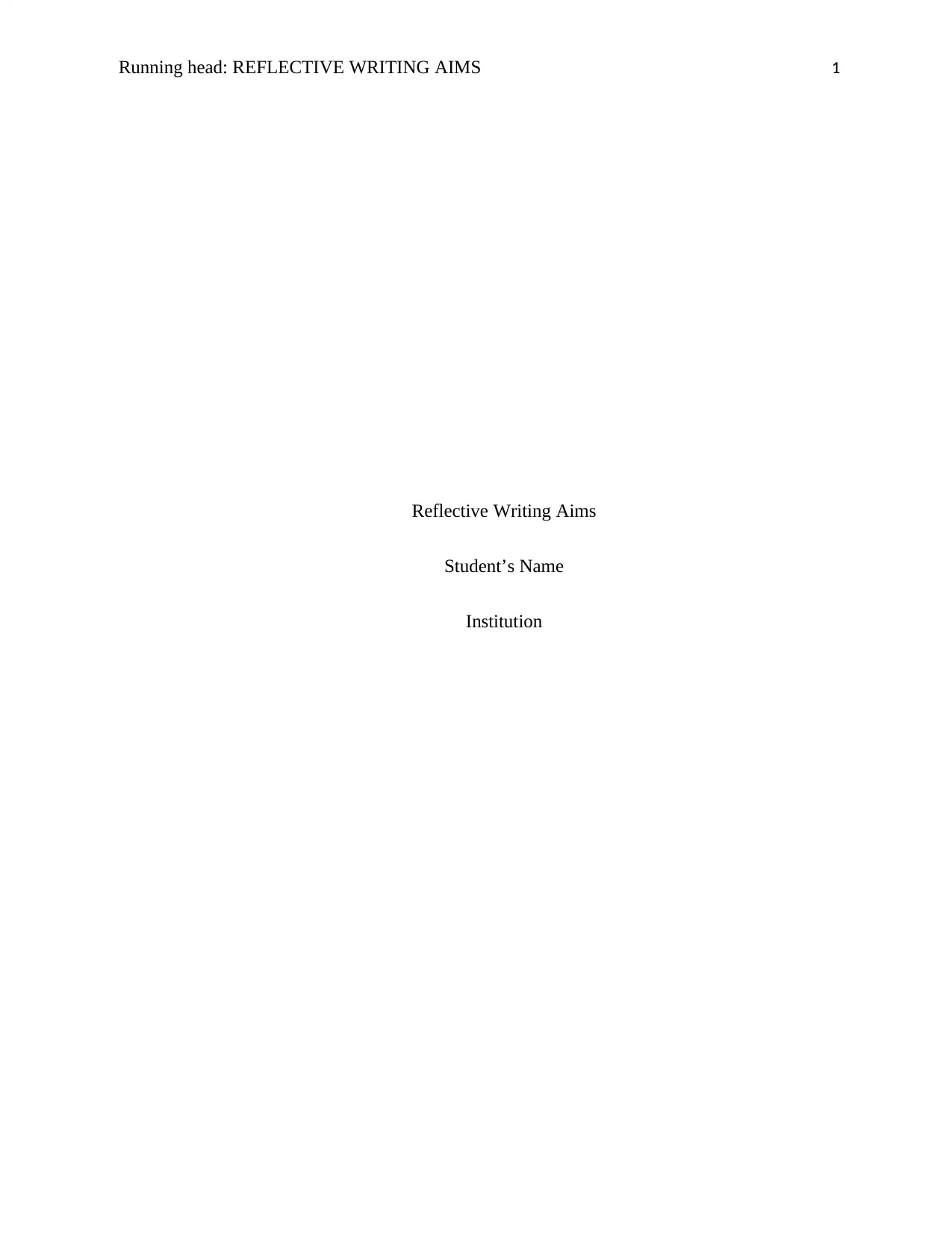
Running head: REFLECTIVE WRITING AIMS 1
Reflective Writing Aims
Student’s Name
Institution
Reflective Writing Aims
Student’s Name
Institution
Secure Best Marks with AI Grader
Need help grading? Try our AI Grader for instant feedback on your assignments.
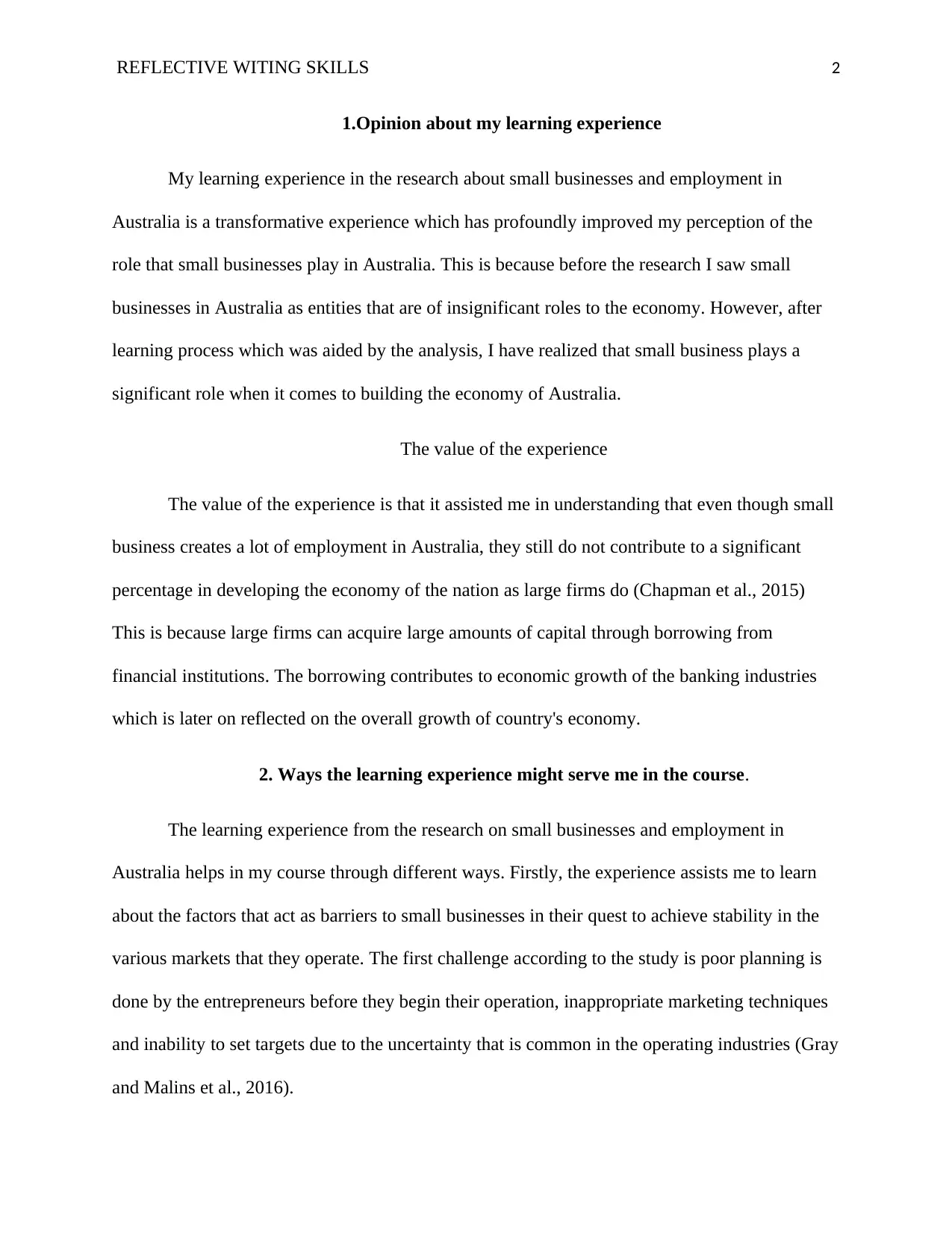
REFLECTIVE WITING SKILLS 2
1.Opinion about my learning experience
My learning experience in the research about small businesses and employment in
Australia is a transformative experience which has profoundly improved my perception of the
role that small businesses play in Australia. This is because before the research I saw small
businesses in Australia as entities that are of insignificant roles to the economy. However, after
learning process which was aided by the analysis, I have realized that small business plays a
significant role when it comes to building the economy of Australia.
The value of the experience
The value of the experience is that it assisted me in understanding that even though small
business creates a lot of employment in Australia, they still do not contribute to a significant
percentage in developing the economy of the nation as large firms do (Chapman et al., 2015)
This is because large firms can acquire large amounts of capital through borrowing from
financial institutions. The borrowing contributes to economic growth of the banking industries
which is later on reflected on the overall growth of country's economy.
2. Ways the learning experience might serve me in the course.
The learning experience from the research on small businesses and employment in
Australia helps in my course through different ways. Firstly, the experience assists me to learn
about the factors that act as barriers to small businesses in their quest to achieve stability in the
various markets that they operate. The first challenge according to the study is poor planning is
done by the entrepreneurs before they begin their operation, inappropriate marketing techniques
and inability to set targets due to the uncertainty that is common in the operating industries (Gray
and Malins et al., 2016).
1.Opinion about my learning experience
My learning experience in the research about small businesses and employment in
Australia is a transformative experience which has profoundly improved my perception of the
role that small businesses play in Australia. This is because before the research I saw small
businesses in Australia as entities that are of insignificant roles to the economy. However, after
learning process which was aided by the analysis, I have realized that small business plays a
significant role when it comes to building the economy of Australia.
The value of the experience
The value of the experience is that it assisted me in understanding that even though small
business creates a lot of employment in Australia, they still do not contribute to a significant
percentage in developing the economy of the nation as large firms do (Chapman et al., 2015)
This is because large firms can acquire large amounts of capital through borrowing from
financial institutions. The borrowing contributes to economic growth of the banking industries
which is later on reflected on the overall growth of country's economy.
2. Ways the learning experience might serve me in the course.
The learning experience from the research on small businesses and employment in
Australia helps in my course through different ways. Firstly, the experience assists me to learn
about the factors that act as barriers to small businesses in their quest to achieve stability in the
various markets that they operate. The first challenge according to the study is poor planning is
done by the entrepreneurs before they begin their operation, inappropriate marketing techniques
and inability to set targets due to the uncertainty that is common in the operating industries (Gray
and Malins et al., 2016).
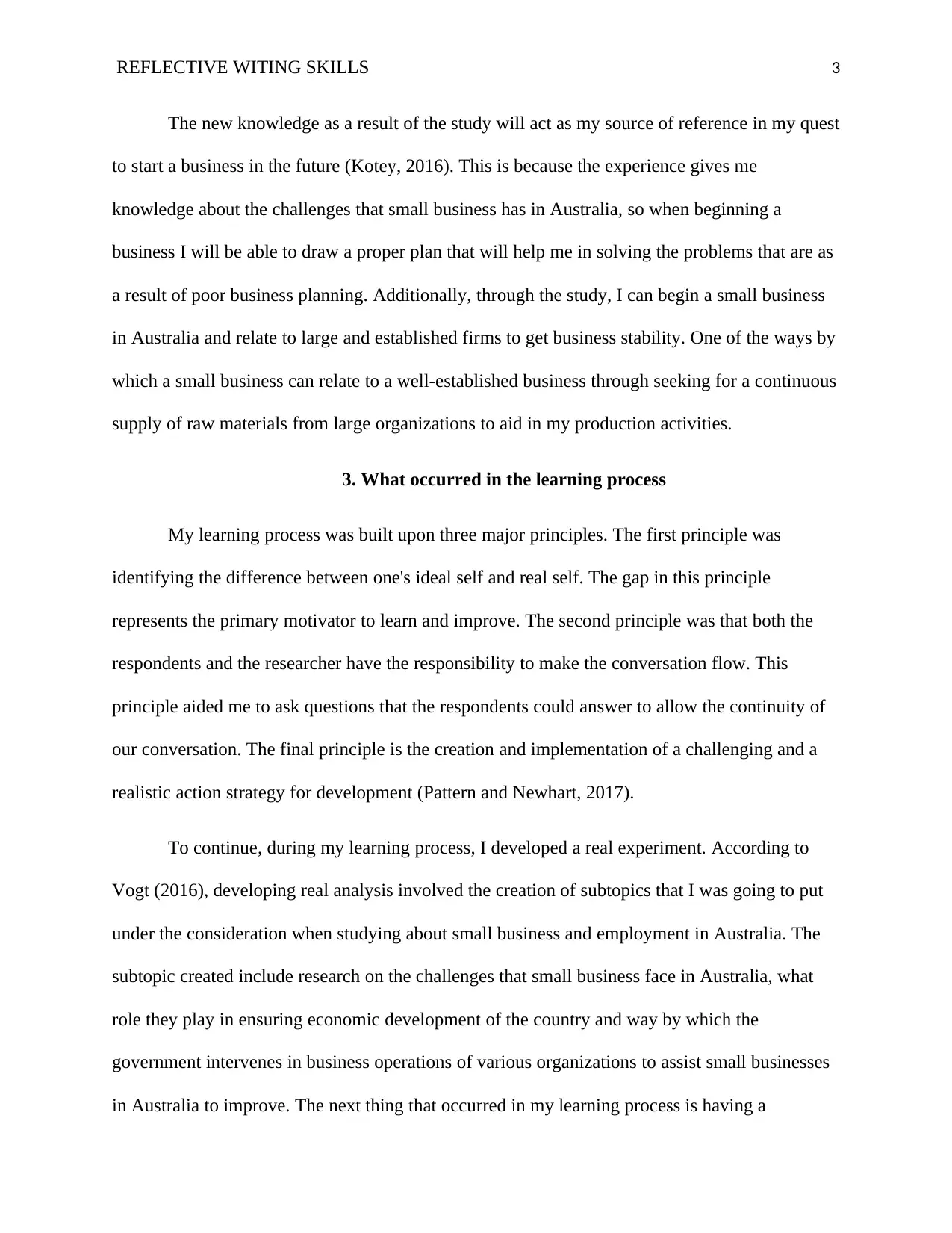
REFLECTIVE WITING SKILLS 3
The new knowledge as a result of the study will act as my source of reference in my quest
to start a business in the future (Kotey, 2016). This is because the experience gives me
knowledge about the challenges that small business has in Australia, so when beginning a
business I will be able to draw a proper plan that will help me in solving the problems that are as
a result of poor business planning. Additionally, through the study, I can begin a small business
in Australia and relate to large and established firms to get business stability. One of the ways by
which a small business can relate to a well-established business through seeking for a continuous
supply of raw materials from large organizations to aid in my production activities.
3. What occurred in the learning process
My learning process was built upon three major principles. The first principle was
identifying the difference between one's ideal self and real self. The gap in this principle
represents the primary motivator to learn and improve. The second principle was that both the
respondents and the researcher have the responsibility to make the conversation flow. This
principle aided me to ask questions that the respondents could answer to allow the continuity of
our conversation. The final principle is the creation and implementation of a challenging and a
realistic action strategy for development (Pattern and Newhart, 2017).
To continue, during my learning process, I developed a real experiment. According to
Vogt (2016), developing real analysis involved the creation of subtopics that I was going to put
under the consideration when studying about small business and employment in Australia. The
subtopic created include research on the challenges that small business face in Australia, what
role they play in ensuring economic development of the country and way by which the
government intervenes in business operations of various organizations to assist small businesses
in Australia to improve. The next thing that occurred in my learning process is having a
The new knowledge as a result of the study will act as my source of reference in my quest
to start a business in the future (Kotey, 2016). This is because the experience gives me
knowledge about the challenges that small business has in Australia, so when beginning a
business I will be able to draw a proper plan that will help me in solving the problems that are as
a result of poor business planning. Additionally, through the study, I can begin a small business
in Australia and relate to large and established firms to get business stability. One of the ways by
which a small business can relate to a well-established business through seeking for a continuous
supply of raw materials from large organizations to aid in my production activities.
3. What occurred in the learning process
My learning process was built upon three major principles. The first principle was
identifying the difference between one's ideal self and real self. The gap in this principle
represents the primary motivator to learn and improve. The second principle was that both the
respondents and the researcher have the responsibility to make the conversation flow. This
principle aided me to ask questions that the respondents could answer to allow the continuity of
our conversation. The final principle is the creation and implementation of a challenging and a
realistic action strategy for development (Pattern and Newhart, 2017).
To continue, during my learning process, I developed a real experiment. According to
Vogt (2016), developing real analysis involved the creation of subtopics that I was going to put
under the consideration when studying about small business and employment in Australia. The
subtopic created include research on the challenges that small business face in Australia, what
role they play in ensuring economic development of the country and way by which the
government intervenes in business operations of various organizations to assist small businesses
in Australia to improve. The next thing that occurred in my learning process is having a
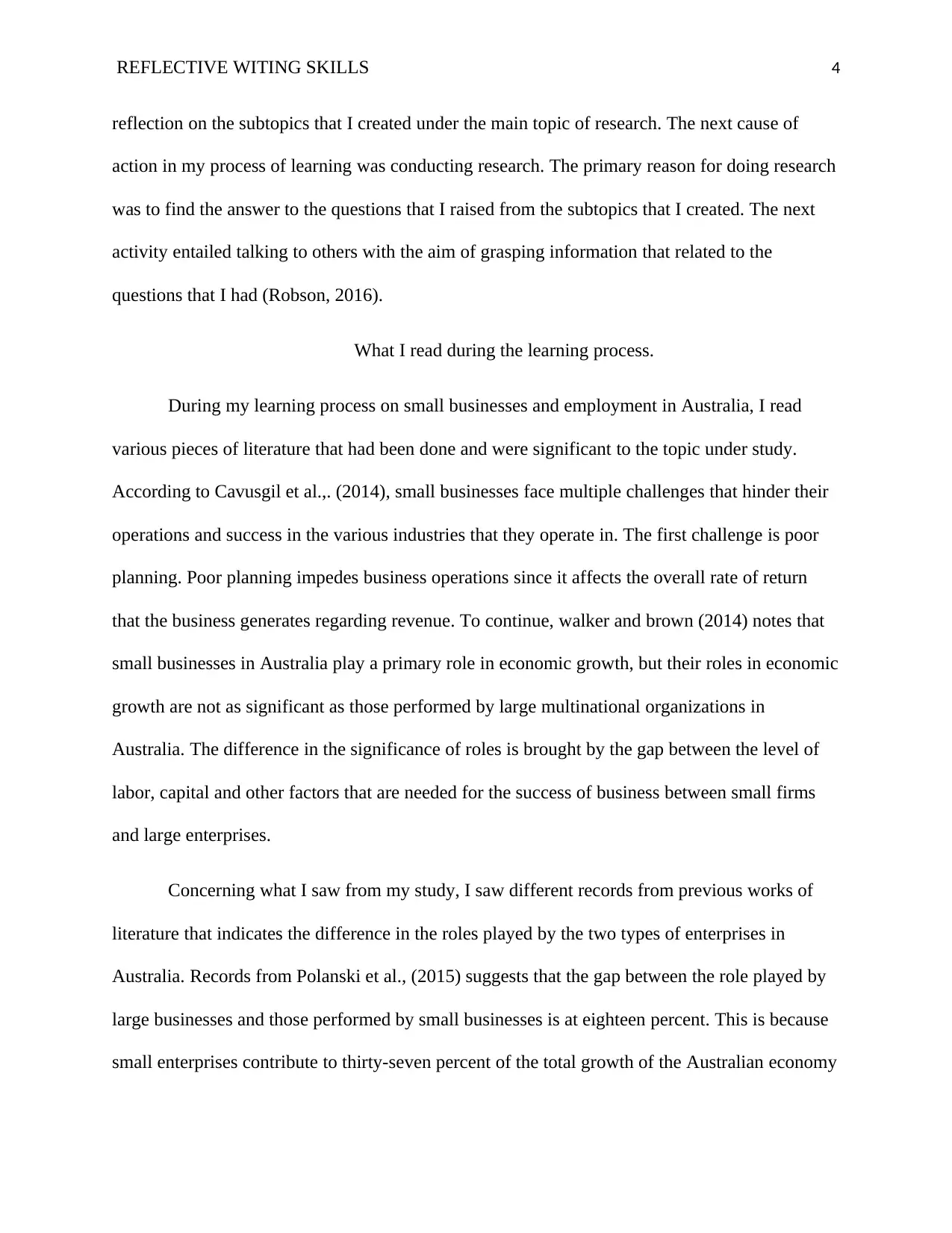
REFLECTIVE WITING SKILLS 4
reflection on the subtopics that I created under the main topic of research. The next cause of
action in my process of learning was conducting research. The primary reason for doing research
was to find the answer to the questions that I raised from the subtopics that I created. The next
activity entailed talking to others with the aim of grasping information that related to the
questions that I had (Robson, 2016).
What I read during the learning process.
During my learning process on small businesses and employment in Australia, I read
various pieces of literature that had been done and were significant to the topic under study.
According to Cavusgil et al.,. (2014), small businesses face multiple challenges that hinder their
operations and success in the various industries that they operate in. The first challenge is poor
planning. Poor planning impedes business operations since it affects the overall rate of return
that the business generates regarding revenue. To continue, walker and brown (2014) notes that
small businesses in Australia play a primary role in economic growth, but their roles in economic
growth are not as significant as those performed by large multinational organizations in
Australia. The difference in the significance of roles is brought by the gap between the level of
labor, capital and other factors that are needed for the success of business between small firms
and large enterprises.
Concerning what I saw from my study, I saw different records from previous works of
literature that indicates the difference in the roles played by the two types of enterprises in
Australia. Records from Polanski et al., (2015) suggests that the gap between the role played by
large businesses and those performed by small businesses is at eighteen percent. This is because
small enterprises contribute to thirty-seven percent of the total growth of the Australian economy
reflection on the subtopics that I created under the main topic of research. The next cause of
action in my process of learning was conducting research. The primary reason for doing research
was to find the answer to the questions that I raised from the subtopics that I created. The next
activity entailed talking to others with the aim of grasping information that related to the
questions that I had (Robson, 2016).
What I read during the learning process.
During my learning process on small businesses and employment in Australia, I read
various pieces of literature that had been done and were significant to the topic under study.
According to Cavusgil et al.,. (2014), small businesses face multiple challenges that hinder their
operations and success in the various industries that they operate in. The first challenge is poor
planning. Poor planning impedes business operations since it affects the overall rate of return
that the business generates regarding revenue. To continue, walker and brown (2014) notes that
small businesses in Australia play a primary role in economic growth, but their roles in economic
growth are not as significant as those performed by large multinational organizations in
Australia. The difference in the significance of roles is brought by the gap between the level of
labor, capital and other factors that are needed for the success of business between small firms
and large enterprises.
Concerning what I saw from my study, I saw different records from previous works of
literature that indicates the difference in the roles played by the two types of enterprises in
Australia. Records from Polanski et al., (2015) suggests that the gap between the role played by
large businesses and those performed by small businesses is at eighteen percent. This is because
small enterprises contribute to thirty-seven percent of the total growth of the Australian economy
Secure Best Marks with AI Grader
Need help grading? Try our AI Grader for instant feedback on your assignments.
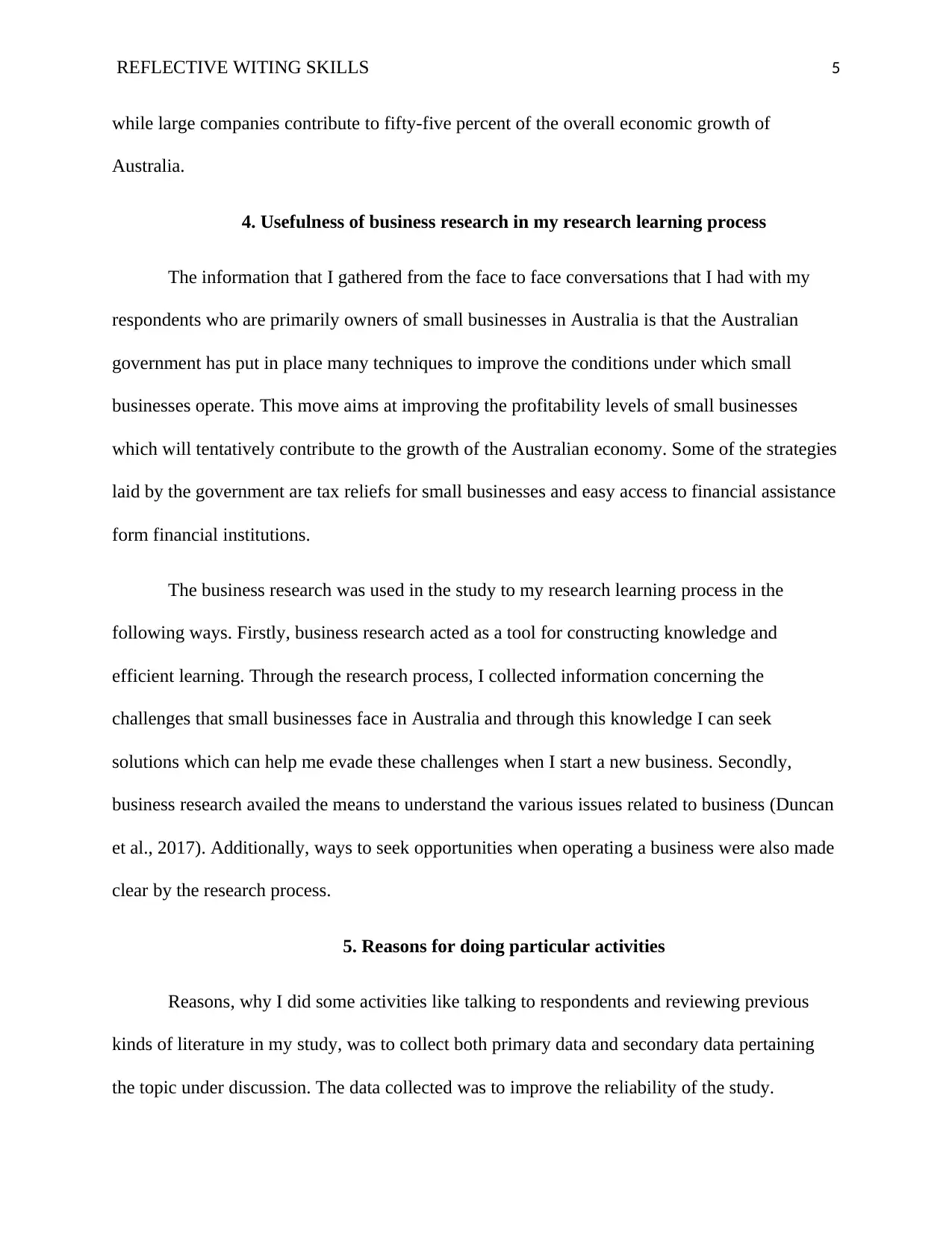
REFLECTIVE WITING SKILLS 5
while large companies contribute to fifty-five percent of the overall economic growth of
Australia.
4. Usefulness of business research in my research learning process
The information that I gathered from the face to face conversations that I had with my
respondents who are primarily owners of small businesses in Australia is that the Australian
government has put in place many techniques to improve the conditions under which small
businesses operate. This move aims at improving the profitability levels of small businesses
which will tentatively contribute to the growth of the Australian economy. Some of the strategies
laid by the government are tax reliefs for small businesses and easy access to financial assistance
form financial institutions.
The business research was used in the study to my research learning process in the
following ways. Firstly, business research acted as a tool for constructing knowledge and
efficient learning. Through the research process, I collected information concerning the
challenges that small businesses face in Australia and through this knowledge I can seek
solutions which can help me evade these challenges when I start a new business. Secondly,
business research availed the means to understand the various issues related to business (Duncan
et al., 2017). Additionally, ways to seek opportunities when operating a business were also made
clear by the research process.
5. Reasons for doing particular activities
Reasons, why I did some activities like talking to respondents and reviewing previous
kinds of literature in my study, was to collect both primary data and secondary data pertaining
the topic under discussion. The data collected was to improve the reliability of the study.
while large companies contribute to fifty-five percent of the overall economic growth of
Australia.
4. Usefulness of business research in my research learning process
The information that I gathered from the face to face conversations that I had with my
respondents who are primarily owners of small businesses in Australia is that the Australian
government has put in place many techniques to improve the conditions under which small
businesses operate. This move aims at improving the profitability levels of small businesses
which will tentatively contribute to the growth of the Australian economy. Some of the strategies
laid by the government are tax reliefs for small businesses and easy access to financial assistance
form financial institutions.
The business research was used in the study to my research learning process in the
following ways. Firstly, business research acted as a tool for constructing knowledge and
efficient learning. Through the research process, I collected information concerning the
challenges that small businesses face in Australia and through this knowledge I can seek
solutions which can help me evade these challenges when I start a new business. Secondly,
business research availed the means to understand the various issues related to business (Duncan
et al., 2017). Additionally, ways to seek opportunities when operating a business were also made
clear by the research process.
5. Reasons for doing particular activities
Reasons, why I did some activities like talking to respondents and reviewing previous
kinds of literature in my study, was to collect both primary data and secondary data pertaining
the topic under discussion. The data collected was to improve the reliability of the study.
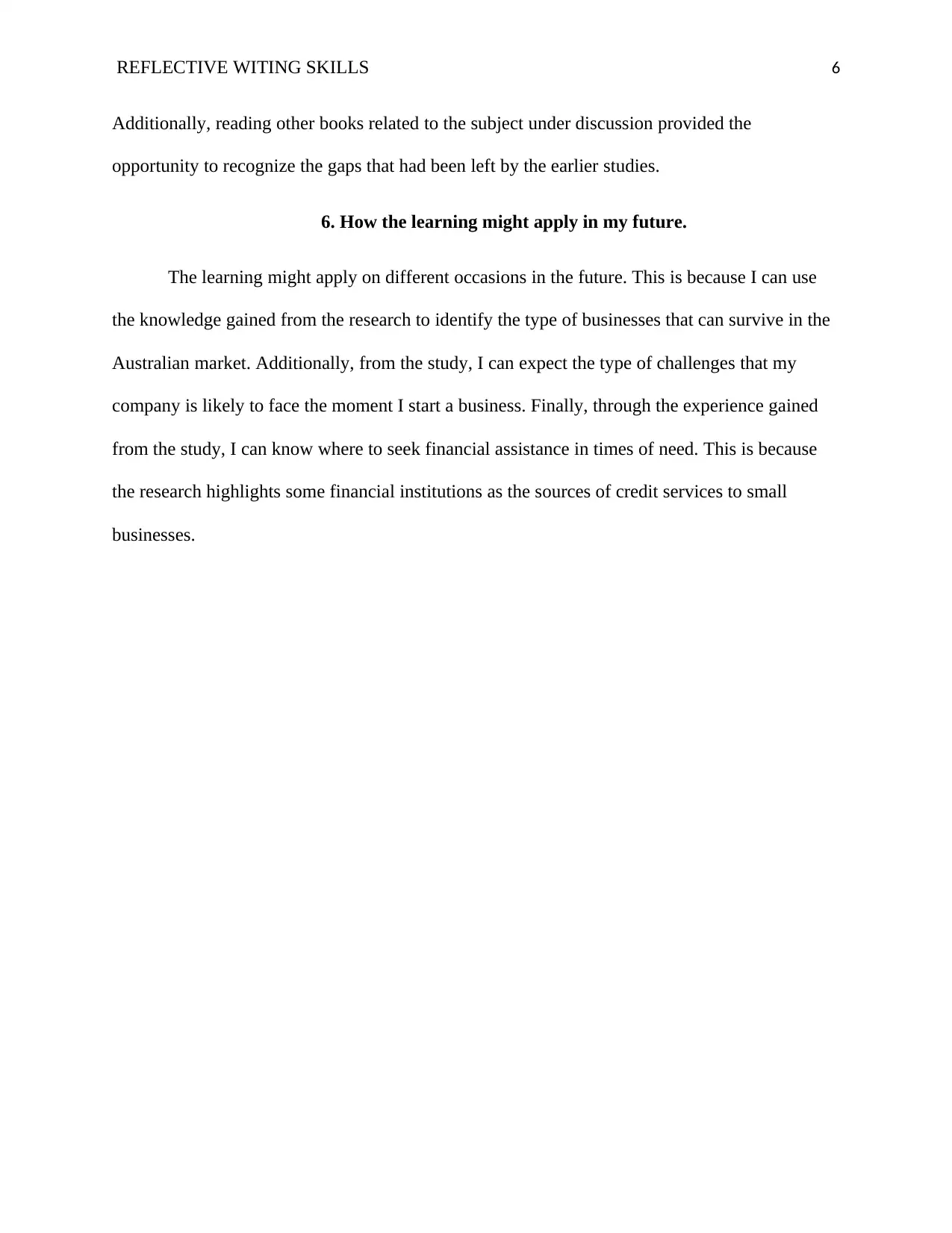
REFLECTIVE WITING SKILLS 6
Additionally, reading other books related to the subject under discussion provided the
opportunity to recognize the gaps that had been left by the earlier studies.
6. How the learning might apply in my future.
The learning might apply on different occasions in the future. This is because I can use
the knowledge gained from the research to identify the type of businesses that can survive in the
Australian market. Additionally, from the study, I can expect the type of challenges that my
company is likely to face the moment I start a business. Finally, through the experience gained
from the study, I can know where to seek financial assistance in times of need. This is because
the research highlights some financial institutions as the sources of credit services to small
businesses.
Additionally, reading other books related to the subject under discussion provided the
opportunity to recognize the gaps that had been left by the earlier studies.
6. How the learning might apply in my future.
The learning might apply on different occasions in the future. This is because I can use
the knowledge gained from the research to identify the type of businesses that can survive in the
Australian market. Additionally, from the study, I can expect the type of challenges that my
company is likely to face the moment I start a business. Finally, through the experience gained
from the study, I can know where to seek financial assistance in times of need. This is because
the research highlights some financial institutions as the sources of credit services to small
businesses.
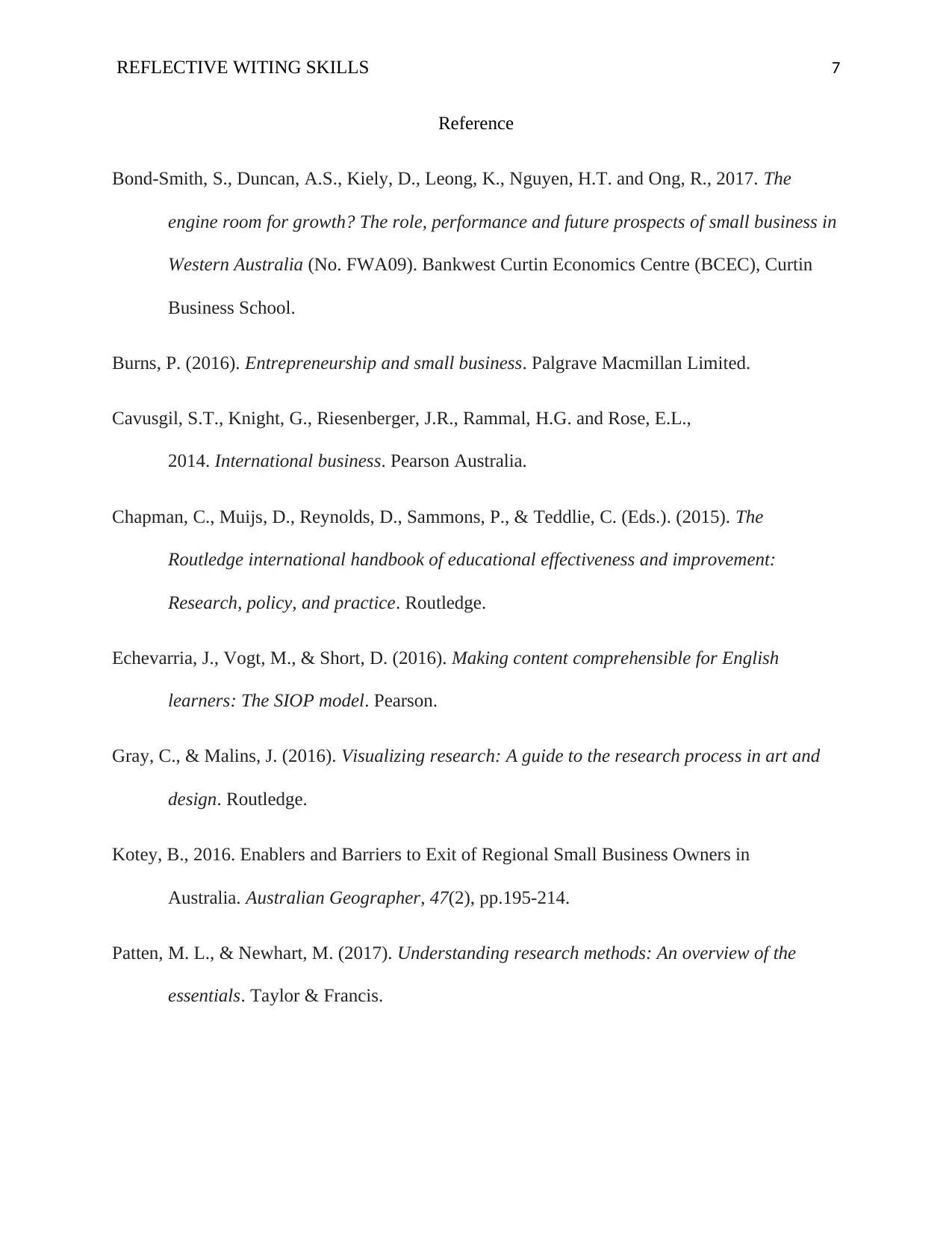
REFLECTIVE WITING SKILLS 7
Reference
Bond-Smith, S., Duncan, A.S., Kiely, D., Leong, K., Nguyen, H.T. and Ong, R., 2017. The
engine room for growth? The role, performance and future prospects of small business in
Western Australia (No. FWA09). Bankwest Curtin Economics Centre (BCEC), Curtin
Business School.
Burns, P. (2016). Entrepreneurship and small business. Palgrave Macmillan Limited.
Cavusgil, S.T., Knight, G., Riesenberger, J.R., Rammal, H.G. and Rose, E.L.,
2014. International business. Pearson Australia.
Chapman, C., Muijs, D., Reynolds, D., Sammons, P., & Teddlie, C. (Eds.). (2015). The
Routledge international handbook of educational effectiveness and improvement:
Research, policy, and practice. Routledge.
Echevarria, J., Vogt, M., & Short, D. (2016). Making content comprehensible for English
learners: The SIOP model. Pearson.
Gray, C., & Malins, J. (2016). Visualizing research: A guide to the research process in art and
design. Routledge.
Kotey, B., 2016. Enablers and Barriers to Exit of Regional Small Business Owners in
Australia. Australian Geographer, 47(2), pp.195-214.
Patten, M. L., & Newhart, M. (2017). Understanding research methods: An overview of the
essentials. Taylor & Francis.
Reference
Bond-Smith, S., Duncan, A.S., Kiely, D., Leong, K., Nguyen, H.T. and Ong, R., 2017. The
engine room for growth? The role, performance and future prospects of small business in
Western Australia (No. FWA09). Bankwest Curtin Economics Centre (BCEC), Curtin
Business School.
Burns, P. (2016). Entrepreneurship and small business. Palgrave Macmillan Limited.
Cavusgil, S.T., Knight, G., Riesenberger, J.R., Rammal, H.G. and Rose, E.L.,
2014. International business. Pearson Australia.
Chapman, C., Muijs, D., Reynolds, D., Sammons, P., & Teddlie, C. (Eds.). (2015). The
Routledge international handbook of educational effectiveness and improvement:
Research, policy, and practice. Routledge.
Echevarria, J., Vogt, M., & Short, D. (2016). Making content comprehensible for English
learners: The SIOP model. Pearson.
Gray, C., & Malins, J. (2016). Visualizing research: A guide to the research process in art and
design. Routledge.
Kotey, B., 2016. Enablers and Barriers to Exit of Regional Small Business Owners in
Australia. Australian Geographer, 47(2), pp.195-214.
Patten, M. L., & Newhart, M. (2017). Understanding research methods: An overview of the
essentials. Taylor & Francis.
Paraphrase This Document
Need a fresh take? Get an instant paraphrase of this document with our AI Paraphraser
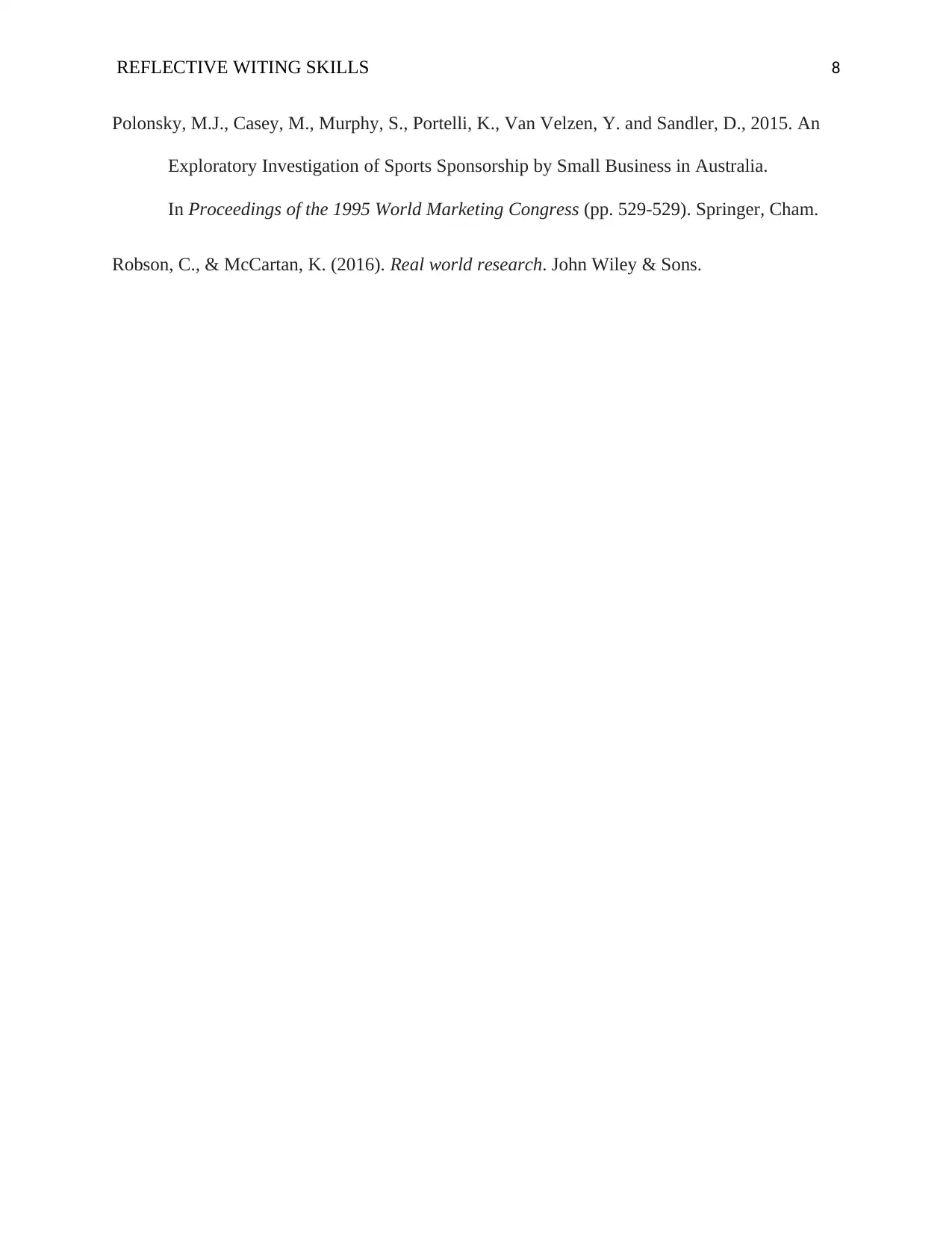
REFLECTIVE WITING SKILLS 8
Polonsky, M.J., Casey, M., Murphy, S., Portelli, K., Van Velzen, Y. and Sandler, D., 2015. An
Exploratory Investigation of Sports Sponsorship by Small Business in Australia.
In Proceedings of the 1995 World Marketing Congress (pp. 529-529). Springer, Cham.
Robson, C., & McCartan, K. (2016). Real world research. John Wiley & Sons.
Polonsky, M.J., Casey, M., Murphy, S., Portelli, K., Van Velzen, Y. and Sandler, D., 2015. An
Exploratory Investigation of Sports Sponsorship by Small Business in Australia.
In Proceedings of the 1995 World Marketing Congress (pp. 529-529). Springer, Cham.
Robson, C., & McCartan, K. (2016). Real world research. John Wiley & Sons.
1 out of 8
Related Documents
Your All-in-One AI-Powered Toolkit for Academic Success.
+13062052269
info@desklib.com
Available 24*7 on WhatsApp / Email
![[object Object]](/_next/static/media/star-bottom.7253800d.svg)
Unlock your academic potential
© 2024 | Zucol Services PVT LTD | All rights reserved.





